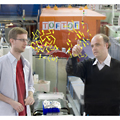Neutrons substantiate new theory on cell membrane motion
Flowing together, instead of jumping alone
22.02.2010, Press releases
Molecules in a cell membrane move in a flowing motion in clusters rather than jumping individually into any empty spaces they find. This is what Sebastian Busch and Dr. Tobias Unruh have proven with data obtained from the TOFTOF (time-of-flight time-of-flight) neutron spectrometer at the research reactor at the Technische Universität München (TUM). The measurements they took, recently published in the renowned Journal of the American Chemical Society, clear up a decade-old puzzle and provide the first experimental substantiation of a new theory of molecular motion.
Sebastian Busch and Tobias Unruh, his doctoral supervisor at the TUM’s FRM II research reactor, watched the simulation of molecular motion on youtube again and again: “They’re not jumping!” And that is exactly what the Finnish scientists working with Ilpo Vattulainen assert. The scientists simulated the cell membrane on a computer and then uploaded the simulation on youtube. For years biophysicists believed in a wrong model: instead of hopping individually from one void to the next, the membrane’s phospholipids actually flow collectively in groups.
For decades arguments had raged between scientists who observed cell membrane motion under the microscope on the micrometer scale and neutron scatterers who measure molecular motions in a nanometer range. Under the microscope it was discovered that the phospholipids moved very slowly in the cell membrane, whereas measurements made with neutrons detected 100 times faster motions. Scientists ultimately explained this apparent contradiction with the theory that the molecules, which are caged in between their neighbors, move back and forth for as long as it takes for a void to become available into which a molecule can jump. And because they do not make such leaps very often, the motion appears slower on the micrometer scale - or so the theory goes.
“No one had ever been able to prove this theory with measurements,” says chemist Tobias Unruh. Also his doctoral student, Sebastian Busch, did not know how to interpret the phospholipid membrane measurements he made at the TOFTOF neutron spectrometer. The data simply did not fit the model. Then he saw the Finnish biophysicists’ simulation, and traveled to the University of Helsinki to find out more. Busch, aged 27 and currently working on his Ph.D. under Professor Winfried Petry through the TUM’s Department of Physics, returned to Garching and took full advantage of the spectrometer’s capabilities to make supplementary measurements. “It was then that I realized I could provide data to substantiate the Finns’ theory,” says Sebastian Busch. He was able to demonstrate the flowing motion of the molecules in his experiments. The cell membrane molecules move like people in a crowd: only when a group of several of them moves in one direction does an individual step forward. Therefore, there are no molecules that jump on their own – only those that flow collectively.
The physicist studied a typical phospholipid, dimyristoylphosphatidylcholine (DMPC), hydrated with heavy water. He observed the motion of the cell membrane at 30°C for times between 35 and 1,000 picoseconds. When the TOFTOF spectrometer is used, neutrons with a precisely determined velocity are selected. They hit the sample and interact with the atomic nuclei. When these are in motion, the speed of the neutrons changes and is measured in a detector. “We have the world’s only spectrometer that can measure these tiny movements on a nanoscale with such high precision,” says Tobias Unruh.
Tobias Unruh and Sebastian Busch now plan to study how the motion of the phospholipids changes when they mix in various substances. Such mixtures are used in drugs. Suitable additives can significantly increase the stability of the drugs. The two TUM scientists are most interested in how the phospholipid motions influence this stabilizing effect. "If we understand the stabilizing mechanism in detail", hopes Tobias Unruh, "optimized mixtures for the particular application can be proposed in the future."
Images (Source: Wenzel Schürmann/TU München):
http://mediatum2.ub.tum.de/?cunfold=965948&dir=965948&id=965948
Link to the simulation by the Finnish scientists on YouTube:
http://www.youtube.com/watch?v=Gzg357buRh8
Publication:
Molecular Mechanism of Long-Range Diffusion in Phospholipid Membranes Studied by Quasielastic Neutron Scattering, S. Busch, C. Smuda, L.C. Pardo Soto, T. Unruh
Journal of the American Chemical Society, Publication Date (Web): February 17, 2010
DOI: 10.1021/ja907581s
Contact:
Dr. Tobias Unruh
Technische Universität München
Forschungs-Neutronenquelle
Heinz Maier-Leibnitz (FRM II)
Lichtenbergstr. 1, 85748 Garching
Tel: +49 89 289 14735
E-Mail -
Website
Kontakt: presse@tum.de
More Information
| 100222_phospholipide_pi.pdf |
Druckversion der Presseinformation (DE),
(Type: application/pdf,
Size: 182.6 kB)
Save attachment
|
|
| 100222_phospholipids_pi_en.pdf |
Printable version of the press release (EN),
(Type: application/pdf,
Size: 164.4 kB)
Save attachment
|




